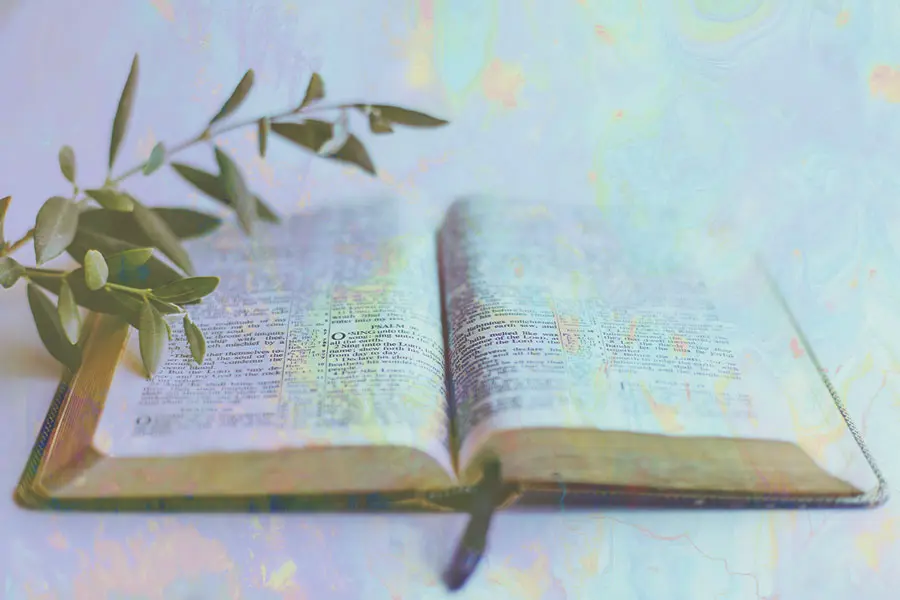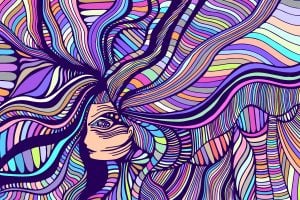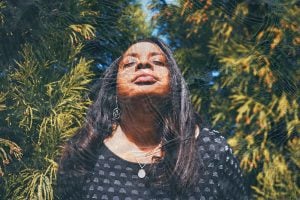Most pills dispensed by doctors and dealers contain a single active ingredient such as MDMA, ketamine, aspirin or diazepam. Traditional medical preparations from ayurveda to ayahuasca work differently, mixing up the medicines to work simultaneously across various physiological processes. We might imagine that medicine becomes more sophisticated over time, but in some ways the evidence tells a different story.
Ancient peoples combined individual medicines to unlock powerful, cumulative effects far greater than the sum of their parts, and the further back we go into human history, the more elaborate the preparations become. In the case of ayahuasca, two main ingredients are combined to generate a mind-blowing psychedelic experience that reveals hidden knowledge. In the book of Exodus, there’s a psychoactive preparation of four herbs and resins that was used to encounter the divine on earth, and it is yet to be surpassed in complexity in the centuries that have passed since.
Feet of Clay: Enzyme Inhibition Across Time
Let’s take enzyme inhibition as our example. Enzymes are biological catalysts that break down molecules. When an enzyme is blocked by inhibitors, it doesn’t work on its target molecule, meaning that certain molecules persist in the body, causing knock-on effects including mood alteration and perceptual fireworks. While many modern day SSRI antidepressants work via this mechanism, enzyme prohibition is nothing new. In fact, mastery over this technique increases as we go back in time, from the vines of Amazonia a thousand years ago to the deserts of Persia and the ancient Israelites.
Modern medicine “discovered” its first enzyme inhibitor in the 1950s, and, like many psychiatric medicines, it was discovered by chance. During research into tuberculosis drugs, isoniazid was found to produce euphoria, as it causes the naturally-occurring serotonin to persist in the synapses of the brain by blocking enzymes. Serotonin, dopamine, and noradrenaline are all monoamines (MAs), and MAs are broken down by monoamineoxidase enzymes (MAOs). MAOs are blocked by MAO inhibitors (MAOis) such as isoniazid. Via these complex pathways, MAOis cause profound changes in neurotransmitter concentration, and therefore in mood and mind.
Today in the US, five of the ten most prescribed psychiatric pharmaceuticals are antidepressants that inhibit enzymes, including Zoloft and Prozac. 12.7 percent of teens and adults take them, and this $14.3 billion market is projected to double in 2020 to $28.6 billion as COVID-19 measures play havoc with our mental health. Even so, they are ineffective in at least a third of cases, and have side effects including headaches, dizziness and erectile dysfunction. These dependency-causing drugs are also implicated in an estimated 90 percent of school shootings.
Ayahuasca is a more sophisticated MAOi, a mixture generally brewed from the chacruna shrub (Psychotria viridis) and the ayahuasca vine (Banisteriopsis caapi). It shows great promise for treating depression where simpler SSRI antidepressants have failed, and also seems to help with PTSD, addiction, and much else besides.
How to Grow Shrooms Bundle
Take Both of Our Courses and Save $90!
It also works because of enzyme inhibition. Chacruna tea consumed alone has no obvious effect because the psychoactive DMT it contains is broken down by MAOs in the gut. These are inhibited, however, by MAOi’s in the vine, allowing DMT to pass into the bloodstream and the brain. Boom!
Ayahuasca is used by shamans to converse with spirits, and has been exported from the forest for at least a thousand years. While many academics assume that indigenous herbalism was learned via “trial and error,” practitioners themselves often simply say that the plants told them. Whatever we might think about this, it took a thousand years for pharmacologists to even begin to catch up with their medical techniques.
Mash-up Messiah
We also have evidence that is older still, and from the other side of the planet, that the Israelites were using enzyme inhibition to make another mind-blowing mixture. Theirs was also more complex, and according to legend, it was taught to the Israelites by their tribal deity (YHWH, god of the Children of Israel). In Exodus 30, the deity gives Moses the recipe of “a Holy Anointing Oil” to be used on in His rites:
“Take thou also unto thee principal spices, of pure myrrh five hundred shekels, and of sweet cinnamon half so much, even two hundred and fifty shekels, and of kaneh-bosm two hundred and fifty shekels, And of cassia five hundred shekels, after the shekel of the sanctuary, and of oil olive an hiyn (5-7 litres).”
The plants listed seem to be myrrh, cannabis and two species of cinnamon.
Myrrh (Commiphora myrrha) works on opioid receptors like an opiate. It constricts the pupils (a common side effect of heroin), and according to Erowid, it produces “euphoria that grows in intensity by the minute.” This is presumably why the Romans infused it into wine for their feasts.
This ancient painkiller was offered to Jesus at his crucifixion, and Proverbs 27 suggests its use as an aphrodisiac: “I have perfumed my bed with myrrh, aloes and cinnamon. Come, let us take our fill of love until morning; let us delight ourselves with love.”
Cannabis was recently discovered in an 8th century BC shrine in Israel, providing hard evidence to support the theory that kaneh-bosm was cannabis. It was found along with frankincense, which is psychoactive via the GABA neurotransmitter system. The synergies among these ingredients at the level of the synapse and the divine are fascinating.
Cinnamon is Ceylon cinnamon (Cinnamomum verum).
Cassia is Chinese cinnamon (Cinnamomum cassia). These two members of the cinnamon family are mildly psychoactive alone, but both act indirectly to make other drugs much more powerful.

Synergies and the Spirit of the Deity
Just as essential oils and cannabis topicals are massaged into the body today, the anointing oil seems to have been a massage oil. In Biblical Hebrew it is shemen ha-mishchah, from the word mashach, meaning to wipe or paint.
One simple synergy at play here concerns absorption. Cinnamon contains eugenol, which increases the absorption of chemicals across the skin, and cinnamaldehyde, which dilates the capillaries. Each component acts in a different way to distribute chemicals of the oil around the body.
Mashach is also the root of mashiyach, “an anointed one.” By the time it was Latinized as “messiah,” the meaning had drifted somewhat, but in the good old days of the Old Testament “mashiyach” was an anointed king. The king was a link between YHWH and His Chosen People, and the connection was forged by the anointing that initiated his reign:
“Then [the prophet] Samuel took the horn of oil, and anointed him in the midst of his brethren: and the Spirit of YHWH came upon [King] David from that day forward.”
Read: Were There Psychoactive Plants in the Bible?
The priesthood were also anointed “that they may minister unto Me [YHWH] in the priest’s office.” In the Tabernacle tent and the Temple of Solomon, anointing was the first stage of a priest’s divine encounter that later involved other resins.
The cannabinoids in cannabis and the opioids in myrrh are both active when used alone (and smoked together they are better still), but cinnamon adds another synergy that profoundly changes the pharmacology. We also find Ceylon cinnamon in traditional Persian medicine as a “convoy medicine” (mogdbareh). Convoy medicines allow other components of a mixture to have their desired effect, and molecular biologists have found that they act via enzyme inhibitors. Where ayahuasca acts on MAO, cinnamon inhibits several enzymes of the cytochrome system.
99 percent of drugs humans encounter are broken down by six different cytochrome enzymes (named CYP3A4, CYP2C9, CYP2C19, CYP1A2, CYP2E1 and CYP2D6). Ceylon cinnamon inhibits the first five. The sixth is inhibited by Chinese cinnamon. Together these two can put the body’s entire drug defense system to sleep, not just increasing the concentration and duration of other psychoactive components in the system but also bringing into play other chemicals in the oil that would usually be broken down. When taken with cytochrome inhibitors, β-caryophyllene makes receptors more sensitive to THC. Relatives of MDMA in the mixture include safrole, elemicin, and estragole; the latter becomes an “electric LSD-like psychedelic” in the presence of inhibitors.

Cinnamomum verum foliage via Wikimedia Commons.
How the High Priest Got Higher
The Tabernacle is the spiritual centre of the Israelite tribe, and its construction is described in minute detail in Exodus. At the back was the Holy of Holies, a perfectly-sealed 4½m3 chamber exclusively for burning incense—in other words, a hotbox. The ancient Israelites weren’t the only ones using them; in the 6th century BC, Herodotus detailed Scythian tribesmen pegging down the flaps of their tent before throwing “kannabis” on red-hot stones, describing how “the Scyths, delighted, shout for joy.”
How to Grow Shrooms Bundle
Take Both of Our Courses and Save $90!
After being anointed, the High Priest would proceed to the Holy of Holy Hotboxes and commune with the angels of YHWH while burning psychoactive resins in large doses—“hands full of sweet incense beaten small” according to Leviticus. According to Exodus it contained “stacte [i.e. myrrh] and onycha [maybe labdanum] and galbanum, sweet incense with pure frankincense.” The Talmud (an ancient book of commentary on the Old Testament) adds saffron, cassia, cinnamon, mastic, costus, spikenard, and agarwood.
Saffron works on opioid receptors. Agarwood impacts GABA, acetylcholine, serotonin, and norepinephrine circuits (and it smells amazing!). Spikenard boosts GABA, dopamine and serotonin. As well as the psychoactive effects, some components protect the synapses from too much dopamine. Others assist with memory formation (lest the words of the angels be forgotten in a haze of THC and tranquilisers). It was clearly a heady mix; the High Priest even had a chain tied to him so the lower priests outside would know if he passed out.
Read: L’Chaim Psilocybin: How Psychedelics are Reigniting Judaism
While the High Priest was alone with the angels in the Tabernacle (or, at a later date, in the Jerusalem Temple) the not-quite-so-high priests would a different preparation called the “showbread” served up with frankincense. The description of the serving in the Talmud does not seem to refer to normal bread, as “every priest who received only the size of an olive became satiated, and some was left over.” Later the dose dropped to “only the size of a bean,” and even so the Talmud reports that:
“The delicate priests refused to take it altogether, but the voracious ones accepted and consumed. It once happened, one took his own share and his fellow’s: He was nicknamed ‘robber’ till his death.”
The tiny dose suggests a psychoactive substance rather than a full meal, and so does the fact that it was too much for some priests and morish for others. Even the sticky nickname is reminiscent of how we relate to our drug-buddies. I still call one of my friends “500 mics” because that was the dose of acid he was on at my talk in London.

Getting Out of Your Head
The Bible has many mysteries, but its drugs are in the open. Another potent hallucinogen in the Bible is mandrake, which is praised in the Song of Solomon and argued over by rival wives in Genesis. Proverbs 27:9 describes how “oil and incense rejoice the heart,” using the verb samach (“to rejoice; be glad“); elsewhere it describes the effect of wine (which is of course psychoactive). The tradition continues into the Gospel, which opens with three wise dealers of the East rocking up with resins and a bag of cash at the nativity of Jesus.
The Book of Exodus, as the name suggests, is about escaping our limitations, but there’s a pharmacological dimension almost entirely unexplored by scholars and scientists alike.
Amazonian shamans learned from their plants. Israelite priests heard the voice of YHWH. Today people who hear voices and talk to plants tend to keep it to ourselves. In the modern world, in theory at least, experts should be book-learned and leaders lucid. Perhaps, as the future rips into the present, it is time to start mixing up the medicines again, to take priests, professors and holy books with a pinch of power plants, and start reading again with fresh eyes.
Taboo and You
Shamans prepare themselves to drink ayahuasca with austerities.
Israelite priests were forbidden from leaving the setting of the Tabernacle when basted and baked, and warned away from “strong drink.” The advice remains good today. Thoughtfulness and research is appropriate, as for any unfamiliar psychedelic, as YHWH and His power plants pack a punch.

DoubleBlind is a trusted resource for news, evidence-based education, and reporting on psychedelics. We work with leading medical professionals, scientific researchers, journalists, mycologists, indigenous stewards, and cultural pioneers. Read about our editorial policy and fact-checking process here.

DoubleBlind Magazine does not encourage or condone any illegal activities, including but not limited to the use of illegal substances. We do not provide mental health, clinical, or medical services. We are not a substitute for medical, psychological, or psychiatric diagnosis, treatment, or advice. If you are in a crisis or if you or any other person may be in danger or experiencing a mental health emergency, immediately call 911 or your local emergency resources. If you are considering suicide, please call 988 to connect with the National Suicide Prevention Lifeline.



